check engine CADILLAC CT5 2023 User Guide
[x] Cancel search | Manufacturer: CADILLAC, Model Year: 2023, Model line: CT5, Model: CADILLAC CT5 2023Pages: 526, PDF Size: 6.85 MB
Page 148 of 526
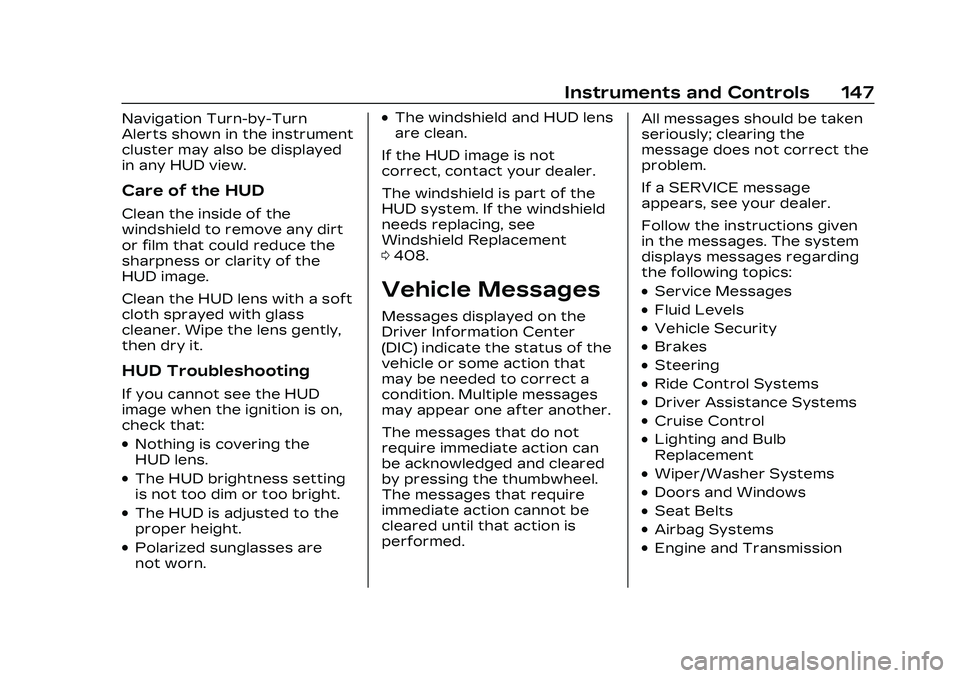
Cadillac CT5 Owner Manual (GMNA-Localizing-U.S./Canada-16500419) -
2023 - CRC - 5/6/22
Instruments and Controls 147
Navigation Turn-by-Turn
Alerts shown in the instrument
cluster may also be displayed
in any HUD view.
Care of the HUD
Clean the inside of the
windshield to remove any dirt
or film that could reduce the
sharpness or clarity of the
HUD image.
Clean the HUD lens with a soft
cloth sprayed with glass
cleaner. Wipe the lens gently,
then dry it.
HUD Troubleshooting
If you cannot see the HUD
image when the ignition is on,
check that:
.Nothing is covering the
HUD lens.
.The HUD brightness setting
is not too dim or too bright.
.The HUD is adjusted to the
proper height.
.Polarized sunglasses are
not worn.
.The windshield and HUD lens
are clean.
If the HUD image is not
correct, contact your dealer.
The windshield is part of the
HUD system. If the windshield
needs replacing, see
Windshield Replacement
0 408.
Vehicle Messages
Messages displayed on the
Driver Information Center
(DIC) indicate the status of the
vehicle or some action that
may be needed to correct a
condition. Multiple messages
may appear one after another.
The messages that do not
require immediate action can
be acknowledged and cleared
by pressing the thumbwheel.
The messages that require
immediate action cannot be
cleared until that action is
performed. All messages should be taken
seriously; clearing the
message does not correct the
problem.
If a SERVICE message
appears, see your dealer.
Follow the instructions given
in the messages. The system
displays messages regarding
the following topics:
.Service Messages
.Fluid Levels
.Vehicle Security
.Brakes
.Steering
.Ride Control Systems
.Driver Assistance Systems
.Cruise Control
.Lighting and Bulb
Replacement
.Wiper/Washer Systems
.Doors and Windows
.Seat Belts
.Airbag Systems
.Engine and Transmission
Page 248 of 526
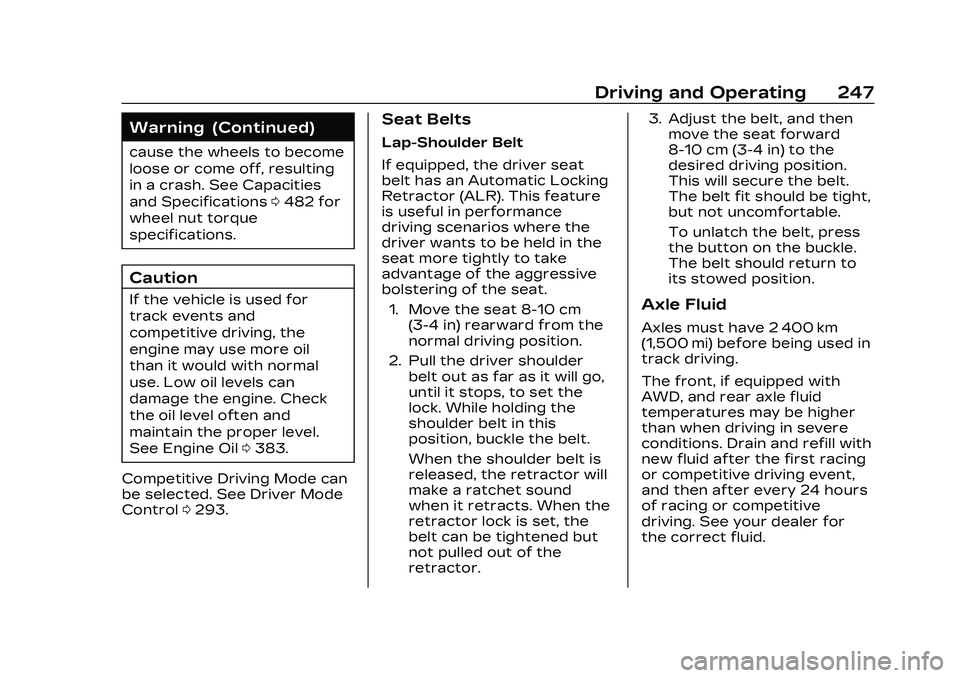
Cadillac CT5 Owner Manual (GMNA-Localizing-U.S./Canada-16500419) -
2023 - CRC - 5/10/22
Driving and Operating 247
Warning (Continued)
cause the wheels to become
loose or come off, resulting
in a crash. See Capacities
and Specifications0482 for
wheel nut torque
specifications.
Caution
If the vehicle is used for
track events and
competitive driving, the
engine may use more oil
than it would with normal
use. Low oil levels can
damage the engine. Check
the oil level often and
maintain the proper level.
See Engine Oil 0383.
Competitive Driving Mode can
be selected. See Driver Mode
Control 0293.
Seat Belts
Lap-Shoulder Belt
If equipped, the driver seat
belt has an Automatic Locking
Retractor (ALR). This feature
is useful in performance
driving scenarios where the
driver wants to be held in the
seat more tightly to take
advantage of the aggressive
bolstering of the seat.
1. Move the seat 8-10 cm (3-4 in) rearward from the
normal driving position.
2. Pull the driver shoulder belt out as far as it will go,
until it stops, to set the
lock. While holding the
shoulder belt in this
position, buckle the belt.
When the shoulder belt is
released, the retractor will
make a ratchet sound
when it retracts. When the
retractor lock is set, the
belt can be tightened but
not pulled out of the
retractor. 3. Adjust the belt, and then
move the seat forward
8-10 cm (3-4 in) to the
desired driving position.
This will secure the belt.
The belt fit should be tight,
but not uncomfortable.
To unlatch the belt, press
the button on the buckle.
The belt should return to
its stowed position.
Axle Fluid
Axles must have 2 400 km
(1,500 mi) before being used in
track driving.
The front, if equipped with
AWD, and rear axle fluid
temperatures may be higher
than when driving in severe
conditions. Drain and refill with
new fluid after the first racing
or competitive driving event,
and then after every 24 hours
of racing or competitive
driving. See your dealer for
the correct fluid.
Page 249 of 526
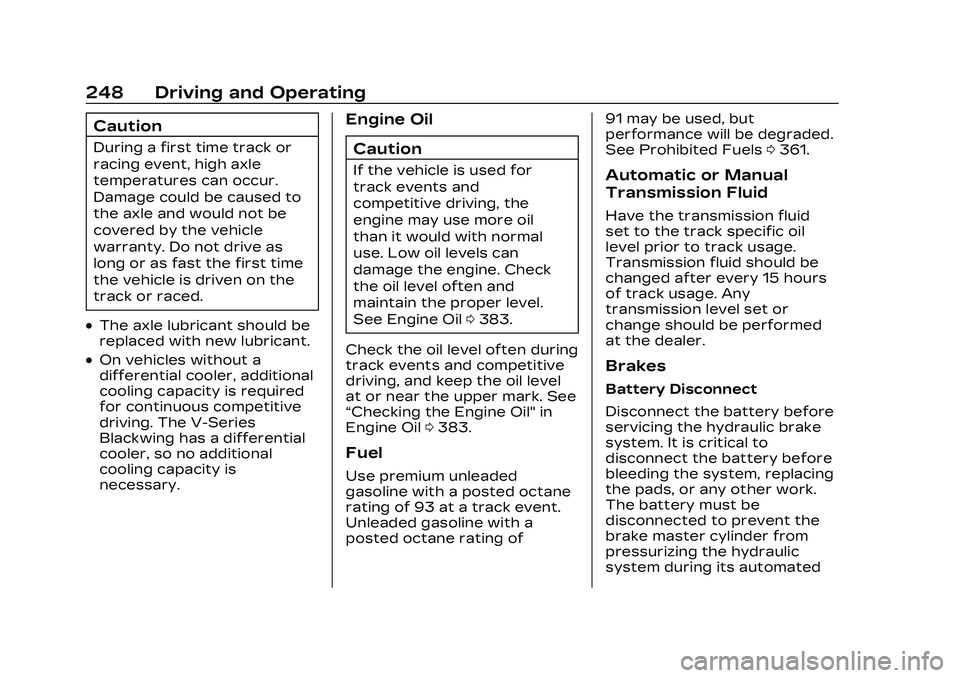
Cadillac CT5 Owner Manual (GMNA-Localizing-U.S./Canada-16500419) -
2023 - CRC - 5/10/22
248 Driving and Operating
Caution
During a first time track or
racing event, high axle
temperatures can occur.
Damage could be caused to
the axle and would not be
covered by the vehicle
warranty. Do not drive as
long or as fast the first time
the vehicle is driven on the
track or raced.
.The axle lubricant should be
replaced with new lubricant.
.On vehicles without a
differential cooler, additional
cooling capacity is required
for continuous competitive
driving. The V-Series
Blackwing has a differential
cooler, so no additional
cooling capacity is
necessary.
Engine OilCaution
If the vehicle is used for
track events and
competitive driving, the
engine may use more oil
than it would with normal
use. Low oil levels can
damage the engine. Check
the oil level often and
maintain the proper level.
See Engine Oil 0383.
Check the oil level often during
track events and competitive
driving, and keep the oil level
at or near the upper mark. See
“Checking the Engine Oil" in
Engine Oil 0383.
Fuel
Use premium unleaded
gasoline with a posted octane
rating of 93 at a track event.
Unleaded gasoline with a
posted octane rating of 91 may be used, but
performance will be degraded.
See Prohibited Fuels
0361.
Automatic or Manual
Transmission Fluid
Have the transmission fluid
set to the track specific oil
level prior to track usage.
Transmission fluid should be
changed after every 15 hours
of track usage. Any
transmission level set or
change should be performed
at the dealer.
Brakes
Battery Disconnect
Disconnect the battery before
servicing the hydraulic brake
system. It is critical to
disconnect the battery before
bleeding the system, replacing
the pads, or any other work.
The battery must be
disconnected to prevent the
brake master cylinder from
pressurizing the hydraulic
system during its automated
Page 260 of 526
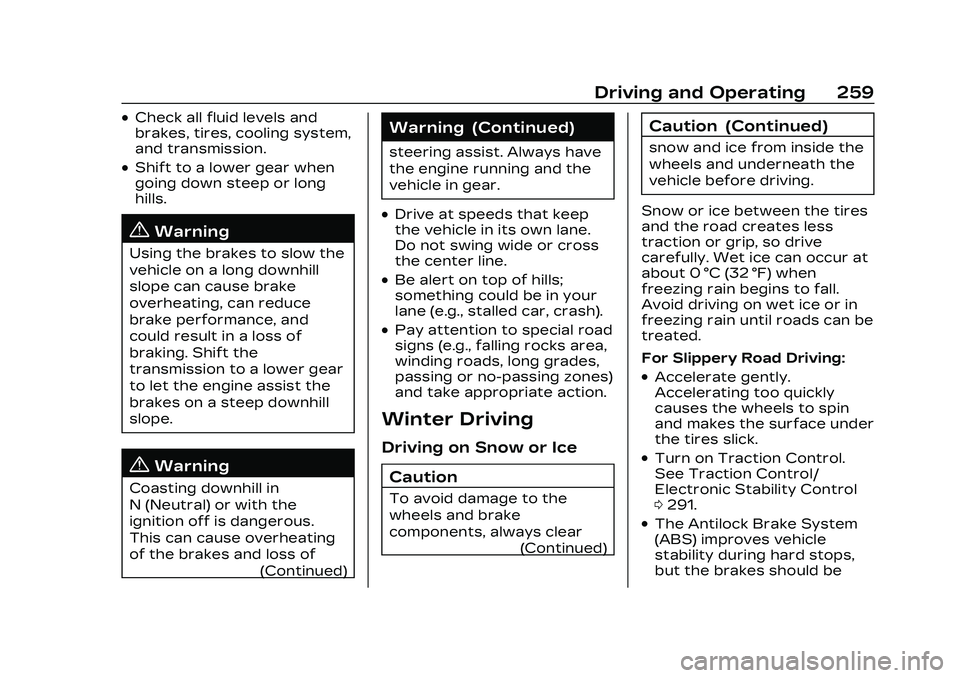
Cadillac CT5 Owner Manual (GMNA-Localizing-U.S./Canada-16500419) -
2023 - CRC - 5/10/22
Driving and Operating 259
.Check all fluid levels and
brakes, tires, cooling system,
and transmission.
.Shift to a lower gear when
going down steep or long
hills.
{Warning
Using the brakes to slow the
vehicle on a long downhill
slope can cause brake
overheating, can reduce
brake performance, and
could result in a loss of
braking. Shift the
transmission to a lower gear
to let the engine assist the
brakes on a steep downhill
slope.
{Warning
Coasting downhill in
N (Neutral) or with the
ignition off is dangerous.
This can cause overheating
of the brakes and loss of(Continued)
Warning (Continued)
steering assist. Always have
the engine running and the
vehicle in gear.
.Drive at speeds that keep
the vehicle in its own lane.
Do not swing wide or cross
the center line.
.Be alert on top of hills;
something could be in your
lane (e.g., stalled car, crash).
.Pay attention to special road
signs (e.g., falling rocks area,
winding roads, long grades,
passing or no-passing zones)
and take appropriate action.
Winter Driving
Driving on Snow or Ice
Caution
To avoid damage to the
wheels and brake
components, always clear (Continued)
Caution (Continued)
snow and ice from inside the
wheels and underneath the
vehicle before driving.
Snow or ice between the tires
and the road creates less
traction or grip, so drive
carefully. Wet ice can occur at
about 0 °C (32 °F) when
freezing rain begins to fall.
Avoid driving on wet ice or in
freezing rain until roads can be
treated.
For Slippery Road Driving:
.Accelerate gently.
Accelerating too quickly
causes the wheels to spin
and makes the surface under
the tires slick.
.Turn on Traction Control.
See Traction Control/
Electronic Stability Control
0 291.
.The Antilock Brake System
(ABS) improves vehicle
stability during hard stops,
but the brakes should be
Page 267 of 526

Cadillac CT5 Owner Manual (GMNA-Localizing-U.S./Canada-16500419) -
2023 - CRC - 5/10/22
266 Driving and Operating
Caution (Continued)
.Check engine oil with
every refueling and add if
necessary. Oil and fuel
consumption may be
higher than normal during
the first
2 414 km (1,500 mi).
.To break in new tires,
drive at moderate speeds
and avoid hard cornering
for the first
322 km (200 mi). New tires
do not have maximum
traction and may tend
to slip.
.New brake linings also
need a break-in period.
Avoid making hard stops
during the first
322 km (200 mi). This is
recommended every time
brake linings are replaced.
.Should the vehicle be used
for racing or competitive
driving (after break-in), the
rear axle lubricant must be
replaced beforehand.See Track Events and
Competitive Driving (V-Series
and V-Series Blackwing)
0246.
On new vehicles, the various
mechanical and electrical
systems experience a
“break-in” period during the
first 6,400 km (4,000 miles) of
routine driving. As the vehicle
is driven, the mechanical
systems adjust to provide
optimal fuel economy and
transmission shift
performance.
Electrical systems will adapt
and calibrate during the
break-in period. A one-time
occurrence of clicks and
similar vehicle noises is normal
during this process.
Normal driving charges the
vehicle’s battery to achieve
the best operation of the
vehicle, including fuel
economy.
Composite Materials
This vehicle may be equipped
with parts containing carbon
fiber, sheet-molding
compound, or other composite
materials. Dealer-installed
accessories may also contain
composite materials.
{Warning
Exposed edges of parts
containing carbon fiber and
other composite materials
can be sharp. Contact with
these parts could result in
injury. Use caution to avoid
contacting these parts,
including when washing the
vehicle. If the parts are
damaged, replace the parts
promptly with replacements
from your dealer.
Page 273 of 526

Cadillac CT5 Owner Manual (GMNA-Localizing-U.S./Canada-16500419) -
2023 - CRC - 5/10/22
272 Driving and Operating
The automatic engine Stop/
Start feature can be disabled
and enabled by pressing
h.
Auto Stop/Start is enabled
each time you start the
vehicle.
When the
hindicator is
illuminated, the system is
enabled.
Engine Heater
Vehicles with the engine
heater can use this option in
cold weather conditions at or
below −18 °C (0 °F) for easier
starting and better fuel
economy during engine
warm-up. Plug in the engine
heater at least four hours
before starting your vehicle.
An internal thermostat in the
plug-end of the cord may exist
which will prevent engine
heater operation at
temperatures above
−18 °C (0 °F).
To Use the Engine Heater
1. Turn off the engine.
Check the heater cord for
damage. If it is damaged,
do not use it. See your
dealer for a replacement.
Inspect the cord for
damage yearly.
2. Plug the heater cord intothe connector in the front
license plate bracket.
3. Plug it into a normal, grounded 110-volt AC
outlet.
{Warning
Improper use of the heater
cord or an extension cord
can damage the cord and
may result in overheating
and fire.
.Plug the cord into a
three-prong electrical
utility receptacle that is
protected by a ground
fault detection function.
An ungrounded outlet
could cause an electric
shock.
.Use a weatherproof,
heavy-duty, 15 amp-rated
extension cord if needed.
Failure to use the
recommended extension
cord in good operating
condition, or using a
damaged heater or
extension cord, could
make it overheat and
(Continued)
Page 276 of 526

Cadillac CT5 Owner Manual (GMNA-Localizing-U.S./Canada-16500419) -
2023 - CRC - 5/10/22
Driving and Operating 275
If the vehicle cannot shift from
P (Park), a Driver Information
Center (DIC) message may be
displayed. Check that the
ignition is on, the engine is
running, the brake pedal is
applied, and the shift lock
release button is pressed
when you are attempting to
shift out of P (Park). If all of
these are met but the vehicle
will not shift out of P (Park),
see your dealer for service.
Parking (Manual
Transmission)
{Warning
If the vehicle has a manual
transmission, never get out
of the vehicle without first
moving the shift lever into
1st or R (Reverse), setting
the parking brake and
turning the ignition off. The
vehicle can roll, which could
cause serious injury or
death.
Parking over Things
That Burn
{Warning
Things that can burn could
touch hot exhaust parts
under the vehicle and ignite.
Do not park over papers,
leaves, dry grass, or other
things that can burn.
Active Fuel
Management
This vehicle's engine may be
equipped with Active Fuel
Management, which allows the
engine to operate on either all
of its cylinders, or in reduced
cylinder operation mode,
depending on the driving
conditions.
When less power is required,
such as cruising at a constant
vehicle speed, the system will
operate in reduced cylinder
operation mode, allowing the
vehicle to achieve better fueleconomy. When greater
power demands are required,
such as accelerating from a
stop, passing, or merging onto
a freeway, the system will
maintain full-cylinder
operation.
If the vehicle has an Active
Fuel Management indicator,
see Driver Information Center
(DIC) for more information on
using this display.
Extended Parking
It is best not to park with the
vehicle running. If the vehicle is
left running, be sure it will not
move and there is adequate
ventilation.
See Shifting Into Park
0273
and
Engine Exhaust 0276.
If the vehicle is left parked and
running with the remote key
outside the vehicle, it will
continue to run for up to
15 minutes.
Page 279 of 526

Cadillac CT5 Owner Manual (GMNA-Localizing-U.S./Canada-16500419) -
2023 - CRC - 5/10/22
278 Driving and Operating
Warning (Continued)
Do not leave the vehicle
when the engine is running.
If the engine has been left
running, the vehicle can
move suddenly. You or
others could be injured. To
be sure the vehicle will not
move, even when on fairly
level ground, always set the
parking brake and place the
transmission into P (Park).
See Shifting Into Park0273
and
Electric Parking Brake 0288.
This vehicle is equipped with
an electronically controlled
transmission. The shift lock
release button is designed to
prevent inadvertent shifting
out of P (Park) unless the
ignition is on, the brake pedal
is applied, and the shift lock
release button is pressed.
When the vehicle is stopped,
press ENGINE START/STOP
to turn off the vehicle. The
transmission will shift to
P (Park) automatically unless
the vehicle is in N (Neutral),
See “Car Wash Mode”
following. The vehicle will not shift into
P (Park) if it is moving too fast.
Stop the vehicle and shift into
P (Park).
To shift in and out of P (Park),
see Shifting Into Park
0273
and
Shifting out of Park 0274.
Service Shift Lever Message
If the message SERVICE
SHIFTER SEE OWNER’S
MANUAL appears in the
Driver Information
Center (DIC), the shift lever
needs service. Have the
vehicle serviced as soon as
possible. If the vehicle is
automatically shifting into
P (Park), check to see if the
P (Park) button on top of the
shift lever is stuck. To operate
the vehicle, hold the shift lever
in the desired gear,
R (Reverse) or D (Drive), until
vehicle speed exceeds
15 km/h (10 mph), then release
the shift lever.
Page 287 of 526

Cadillac CT5 Owner Manual (GMNA-Localizing-U.S./Canada-16500419) -
2023 - CRC - 5/10/22
286 Driving and Operating
No Lift-Shift
The vehicle can be shifted up
a gear when the accelerator
pedal is pressed to the floor
without being released. This
allows for less power
interruption and will improve
acceleration times. This
feature is available in all
vehicle modes and is only
active when the engine speed
is greater than 5000 rpm.
Active Rev Match
Vehicles equipped with a
manual transmission have
Active Rev Match (ARM). ARM
aids in smoother shifting by
matching the engine speed to
the next selected gear. By
monitoring shift lever and
clutch operation, ARM adjusts
engine speed to match a
calibrated value based on gear
selection. On upshifts and
downshifts, engine speed will
be increased and decreased to
match vehicle road speed and
transmission gear position.ARM is maintained while the
clutch pedal is pressed, but
will deactivate if the shift lever
is left in the Neutral position.
The system is activated and
deactivated by pressing the
ARM switch on the center
console. The system must be
activated with each new
ignition cycle. If ARM is
deactivated, the system will
still perform rev matching for
upshifts.
A gear indicator in the
instrument cluster displays the
current gear selected. ARM is
also shown in the
Performance View of the HUD:
.When ARM is activated, the
gear number is amber.
.When ARM is deactivated,
the gear number is white.
.If no gear number is
displayed while the shift
lever is in gear, service is
required. All rev matching will
be disabled, and the
malfunction indicator lamp
will be on. See Malfunction
Indicator Lamp (Check
Engine Light)
0125. The
clutch and manual
transmission will continue to
operate normally.
ARM will also:
.Be active above 28 km/h
(18 mph).
.Match engine speed up to
5400 rpm.
.Not operate when the
accelerator pedal is applied.
Page 292 of 526
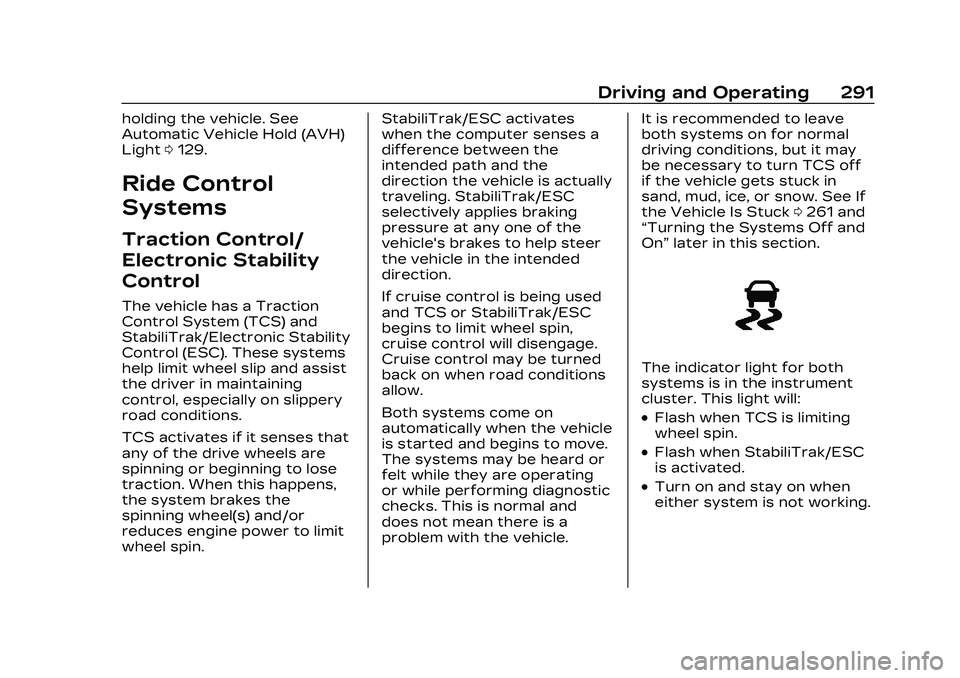
Cadillac CT5 Owner Manual (GMNA-Localizing-U.S./Canada-16500419) -
2023 - CRC - 5/10/22
Driving and Operating 291
holding the vehicle. See
Automatic Vehicle Hold (AVH)
Light0129.
Ride Control
Systems
Traction Control/
Electronic Stability
Control
The vehicle has a Traction
Control System (TCS) and
StabiliTrak/Electronic Stability
Control (ESC). These systems
help limit wheel slip and assist
the driver in maintaining
control, especially on slippery
road conditions.
TCS activates if it senses that
any of the drive wheels are
spinning or beginning to lose
traction. When this happens,
the system brakes the
spinning wheel(s) and/or
reduces engine power to limit
wheel spin. StabiliTrak/ESC activates
when the computer senses a
difference between the
intended path and the
direction the vehicle is actually
traveling. StabiliTrak/ESC
selectively applies braking
pressure at any one of the
vehicle's brakes to help steer
the vehicle in the intended
direction.
If cruise control is being used
and TCS or StabiliTrak/ESC
begins to limit wheel spin,
cruise control will disengage.
Cruise control may be turned
back on when road conditions
allow.
Both systems come on
automatically when the vehicle
is started and begins to move.
The systems may be heard or
felt while they are operating
or while performing diagnostic
checks. This is normal and
does not mean there is a
problem with the vehicle.
It is recommended to leave
both systems on for normal
driving conditions, but it may
be necessary to turn TCS off
if the vehicle gets stuck in
sand, mud, ice, or snow. See If
the Vehicle Is Stuck
0261 and
“Turning the Systems Off and
On” later in this section.
The indicator light for both
systems is in the instrument
cluster. This light will:
.Flash when TCS is limiting
wheel spin.
.Flash when StabiliTrak/ESC
is activated.
.Turn on and stay on when
either system is not working.